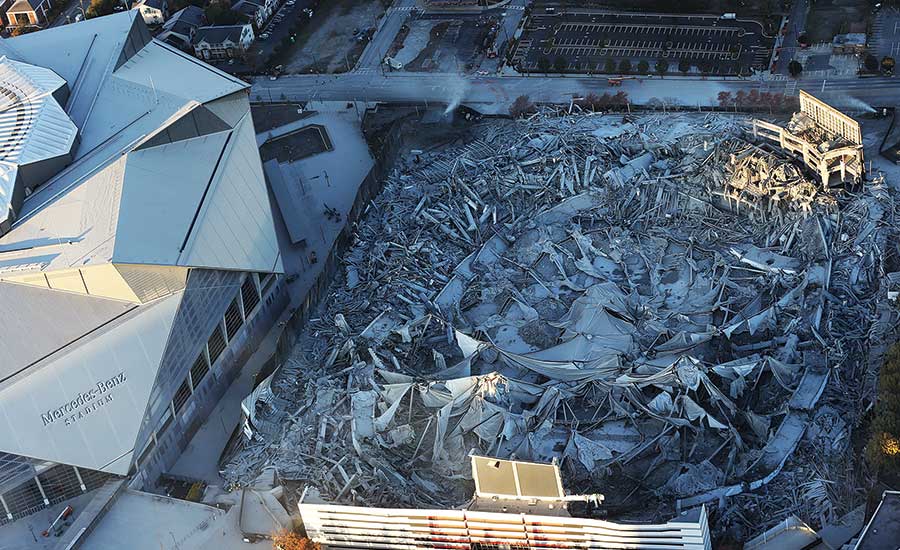An estimated 4,800 pounds of explosives took just 12 seconds to take down the 25-year-old Georgia Dome, a structure that broke new ground for cable-supported fabric roofs. The Nov. 20 implosion “went off perfect,” says Rick Cuppetilli, executive vice president with Detroit-based Adamo Group Inc., the demolition contractor. The stadium featured a unique design, with its roof anchored to a concrete cast-in-place compression ring that measured 2,300 ft in circumference, according to the website of Thornton Tomasetti, a structural designer for the original construction project.
In addition to being the only stadium ever built with its roof and compression ring design—and therefore “the only one ever demolished,” Cuppetilli says—the Georgia Dome was a “very stout structure,” he adds, featuring 6-ft-by-5-ft cast-in-place concrete columns on its perimeter. To take down the stadium—which sat surrounded by Mercedes-Benz Stadium, the Georgia World Congress Center as well as a MARTA subway line—crews spent 11 days drilling more than 3,000 holes and placing the 4,800 pounds of explosives.
"Our number 1 priority was the roof and the ring, which fell in beautifully,” Cuppetilli explains. The second priorities were the two nearby structures—the Mercedes dome, and the Georgia World Congress Center, which was connected to the Georgia Dome. As with the roof and ring, says Cuppetilli, the sections adjacent to those two structures “folded in beautifully, perfectly.”
The section planned to be the last to fall, along Mangum Street, failed to collapse, however.
“Because it’s a circular structure, you have to have a last section,” he says, adding that it’s “not uncommon” for the “last” sections of an implosion to remain at least partly standing. In the case of the Georgia Dome, he says, “My guess is because it was a long implosion of 12 seconds with 1,000 delays (that) something got severed, even though it’s double-wired and everything else.”
The adjacent MARTA subway line, which was closed due to the implosion, re-opened for service as scheduled, Cuppetilli says.
Led by the joint venture of Beers Construction Co., Holder Construction Co. and Barton Malow Co., construction of the $214-million Georgia Dome project began in November 1989, and was completed in March 1992, according to the Georgia World Congress Center Authority. Upon its opening, it was the world’s largest covered stadium, and featured the world’s largest cable-supported fabric roof.





Post a comment to this article
Report Abusive Comment